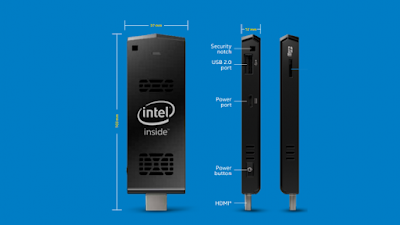We love Micro PCs. From the Intel NUC to the MSI Cubi,
having a proper Windows Computer in a box as big as a pack of posh truffles is
a fantastic and cheap alternative to an all-in-one PC for those short of space.
The latest fad, as evinced by the slew of models currently
available from Hannspree, Lenovo and Intel, is to take advantage of Intel Atom
processors' small size and low power requirements and to make a PC not much
bigger than a Wi-Fi dongle. However, as we found in our review of the Hannspree
Micro PC, that although this is an impressive feat of engineering, the
resulting PC is so frustratingly limited that we're not sure we see the point.
The Intel Compute Stick is Intel's own Micro PC design, and
is almost identical to the Hannspree model. You get the same compact chassis
with an HDMI plug on the end, the same quad-core "Bay Trail" Intel
Atom Z3735F system-on-chip and the same 2GB RAM and 32GB storage. The stick is
powered from a microUSB connector, but you'll need a 2A power supply; as we
expected, the 0.5A USB socket on the back of our TV couldn’t get the Compute
Stick to boot. The model we reviewed comes with Windows 8.1 with Bing, but
there's also an Ubuntu version available for £90. That edition only has 8GB
storage, though, so would work best if you keep most of your files in the
cloud.
The limitations of such a small PC are evident as soon as
you set it up. The single USB port is one of the bigger problems. This means if
you want to have a keyboard and mouse plugged in at the same time, you need to
use a wireless model with a single receiver. Even then, there's nowhere to plug
in a card reader or a USB drive, so getting files on and off the Compute Stick
could be a bit tricky.
This is an old-fashioned way of looking at things, of
course; you could just use Dropbox, OneDrive or equivalent for your file
transfers and upload photos straight from your smartphone or Wi-Fi-enabled
camera. However, such thoughts of wireless freedom are somewhat stymied by the
Compute Stick's poor Wi-Fi connection. It's an 802.11n rather than 802.11ac
chipset, but only supports the 2.4GHz rather than 5GHz band. This limits where
you can use the Compute Stick; in our study, around 10m from the wireless
router, a Speedtest.net benchmark showed the Compute Stick could download at
less than 0.1Mbit/s - an unusably slow connection. By contrast, a Tesco Hudl 2
in the same room could max out our 38Mbit/s fibre broadband connection thanks
to its 5GHz 802.11n support. You'll have to have the Compute Stick near your
router to have any kind of usable network speed.
The single USB port means this is a tricky situation to
rectify, as you can’t even plug in a USB Wi-Fi dongle. If you want to add USB
ports there's always the option of a hub, but you'll need a powered model; we
tried a passive hub and it couldn’t even power a wireless keyboard adaptor and
a USB key at the same time. The Compute Stick does have built-in Bluetooth, but
Windows' Bluetooth support has always been poor, and we experienced plenty of
disconnections with our test Bluetooth keyboard (which is difficult to rectify
when you don’t have any input devices plugged in). You can also use Intel's
Remote Keyboard app on your smartphone or tablet in conjunction with a server
on the Compute Stick, which works reasonably well for some light web browsing.
The Compute Stick has the same quad-core 1.33GHz Intel Atom
Z3735F processor as the Hannspree Micro PC, and its performance isn’t up to
much. It scored just 9 overall in our benchmarks, hindered by a particularly
poor score of 2 in the multitasking benchmark. Intel's micro PC did complete
the multitasking section of the benchmark in half the time of Hannspree's,
however, possibly due to having better heat dissipation.
The Compute Stick copes with most tasks fairly well, such as
browsing the web or playing Full HD video, but try opening a web page in
another tab while one is still rendering and everything will grind to a halt.
The Compute Stick also takes forever to install updates on shutdown; at one
point it took 30 minutes to install nine updates, which is tricky for a
portable device which you're meant to take with you (Windows doesn’t take
kindly to being interrupted mid-update so you can get your train).
All this left us wondering what we could use the Compute
Stick for. It's a reasonable web browsing and email/word processing device (if
you have a Wi-Fi printer) but for a basic Windows machine we’d rather find a
couple of hundred pounds and build a PC ourselves, complete with enough USB
ports to actually plug things in. It's not even, as has been suggested in some
quarters, a Chromecast substitute, as Chromecast has many features the Compute
Stick doesn’t, such as the ability to play HD films from the Google Play store
on your TV.
One use does stand out, however; you could use the Compute
Stick as a UPnP media server and renderer. With a high-capacity microSD card
for your music, a media server such as Serviio installed and using the
Foobar2000 music player with the UPnP plugin, we could play music through our
TV via the Compute Stick, controlling which tracks were played from an Android
tablet running BubbleUPnP. However, you could also use a £30 Raspberry Pi
running OpenELEC for the same purpose.
It may be tiny and relatively cheap, but the Compute Stick
is seriously limited. It has its niche uses, such as that mentioned in the
paragraph above, but if you're after a properly useful tiny PC you're better
off saving up for something a bit more useful, like an MSI Cubi.





0 comments:
Post a Comment